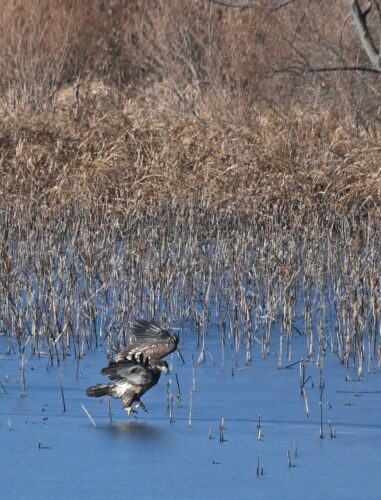Eagles: On winter bird watcher list

PHOTO BY GARRY BRANDENBURG — A big bird like a bald eagle is often times hard to miss. This large raptor may be gliding along over farm fields or picking away at some road killed critter. In either case, it is good to observe the antics and behavior of eagles, especially over open water such as at Lake Red Rock dam, where fish dominate their menu. In today's images, an adult bald eagle was observed along a tree line. A long lens was able to capture its wide spread wings just after it launched itself from a tree branch. In the other image, an immature bald eagle was on the ice at Hendrickson Marsh this past week. The bird was chasing something under the ice, but the ice was too thick for its talons or beak to break through. Several Christmas time bird counts get under way during December.
Winter bird counts will soon be increasing observation times by birders all across the United States. By conducting a citizen science activity of recording winter birds at wildlife areas, or even backyard sites, a compilation of species list is updated. Bird watching is a terrific hobby that allows one to take part at any level, casual to intense, and record those sightings to official bird watching organizations.
Every year, a Bald Eagle survey is conducted to try and tabulate the total number of eagles in Iowa. The number is likely to be about 5,000. High volume areas are the entire Mississippi River of Iowa’s eastern border. Every city along Iowa’s border — Harper’s Ferry, Lansing, Marquette, McGregor, Guttenberg, Dubuque, Bellevue, Clinton, Davenport or Burlington, and others, will continually have eagles to observe.
However, eagles can be found everywhere in Iowa. I am constantly made aware of that fact when driving cross country, well away from big rivers, and seeing predominantly open fields of last year’s corn or soybean crops.

A large dark colored bird sitting in the field will certainly get my ten power binoculars aimed at it in an attempt to get a better look. Many times, the eagle is just resting.
At other times, the big raptor is contemplating its next morsel of raccoon, rabbit or road-killed deer. Eagles can and are part of Mother Nature’s winter time clean up crew. The dead animals they feed upon create energy for the living eagle.
Eagle eyes have an acuity of at least four to eight times sharper than a human eye. Their eyes are fixed in their sockets, so the bird must turn its head to look around.
If a small rodent or rabbit makes a move, the eagle is likely to see that movement and then figure out a way to capture that new potential food source. Above the eye of an eagle is a bony supra-orbital ridge of its skull. This ridge provides protection to the eye when capturing or handling prey. The skull ridge also acts as a sunshade, with its feathered covering, to reduce sunlight glare.
The gritty side of nature and its life and death struggles takes place all the time. Here is where some people get in the way, when they allow emotions to override facts.
At an eagle nest site in Minnesota about seven years ago, a nest had a remote camera monitor in place. People could watch the nest 24/7 if they so chose.
In the nest was an eagle chick, and it was obvious it was not doing well for a myriad of unknown reasons. An outcry from some people asked authorities to “do something.” The experts listened and commented back. What they did, the something, was the right thing, and it was precisely to not interfere.
While people’s empathy may be triggered, experts take the long view of what is best. After all, wild animals are not pets.
Most eagle nestings end up successfully raising one of two eaglets to flight status, well on their way to adulthood. The overall population of Bald Eagles from Alaska to Florida, and California to Maine, is doing very well.
———
Christmas bird count day in Marshall County has been set for Dec. 19, an all day or as long as one has time to spend, activity. This count is being organized by the Marshall County Conservation staff. Do call weekdays to 641-752-5490 to find an area and other enthusiasts to join up with.
Please call before Dec. 15 to sign up. It is a free activity.
The count area is a circle 30 miles in diameter centered just north of Marshalltown. For the past 124 years, this Audubon Society bird count has taken place all across the USA. A specific day is designated locally, and can cover the entire 24 hour period. The Conservation Board staff will assist you in finding a zone and other observers to team up with.
———
There are a few December happenings to take note of as we approach Christmas time. First season gun deer hunting season ended on Dec. 6. Gun hunters harvested about 30,000 during that first five day long time frame.
Today, the 9th, is the beginning of Iowa deer gun season number two, which continues through Dec. 17. The late muzzleloader and late archery deer season restarts on Dec. 18 and goes through Jan. 10, 2024.
The middle of December, specifically the 13th and 14th, will be peak times to observe in the nighttime sky, meteor showers from the Geminid meteor. Predictions hold that if clear skies exist, one may see up to 120 meteors per hour.
Possible meteor showers can happen from the 19th to the 24th, mid evening with peak time being around 2 a.m. Ideal conditions will be a clear dark sky with minimal moon.
Dec. 15 is the date new 2024 hunting, fishing and fur harvester licenses go on sale. It may be a perfect gift for the outdoor enthusiasts in your family.
The winter solstice, the first day of winter season, is Dec. 21. The shortest day lengths will actually be Dec. 21-24 at 9 hours and 6 minutes for us folks in Marshall County. Our earliest sunsets for the month have or will happen between Dec. 8 and the 11th.
Sunsets were at 4:38 p.m. Our latest sunrises are yet to come on Jan. 3-6 at 7:39 a.m. After that, day lengths will slowly begin to get longer.
The Earth is actually closer to the sun now than it will be in June of next year. It is the tilting of the axis of the Earth away from the sun that does not allow for a more intense insolation of light.
And for you history buffs, on Dec. 28, 1846, Iowa was admitted to the Union of the United States as the 29th state. During those intervening 177 years, the land between two rivers (Missouri and Mississippi), in the heart of the Midwest, has seen a whole lot of changes to its rich prairie grasslands heritage.
Much is positive, some not so much. As for native prairie grasslands, only 1/10 of one percent remain. There has been a renewed growth in using native grasses and forbs in conservation reserve programs.
Forest land acreage in 1846 was estimated at 13 percent of Iowa, mostly along the major rivers and interior river corridor valleys. Wetlands and glacial lakes or ponds, both permanent and ephemeral, made up the remaining 2 percent of Iowa.
Iowa has 55,857.13 square miles of land within its borders. If the original prairie was about 85 percent, that means 47,478 plus square miles of grasses, 7,261 plus square miles of forests and timber. Wetlands and water in natural lakes made up the balance with 1,117 plus square miles.
———
Christmas tree sales at the Izaak Walton League continue this weekend and next weekend. Trees of any size are $50. Cut your own and cut it to fit your home space. Tall trees may also provide the top half with just what you need or want for smaller spaces.
Look them over and make a choice. Hours for each Saturday and Sunday are 10 a.m. until 4 p.m. The Ikes land is located southeast of Marshalltown on Smith Avenue. Look for the driveway at the top of the hill, west side of the roadway.
———
Advice from an Eagle — Let your spirit soar; See the big picture; Cherish freedom; Honor the Earth and sky; Keep your goals in sight; Bald is beautiful; Fly high.
———
Garry Brandenburg is the retired director of the Marshall County Conservation Board. He is a graduate of Iowa State University with a BS degree in Fish & Wildlife Biology.
Contact him at:
P.O. Box 96
Albion, IA 50005

